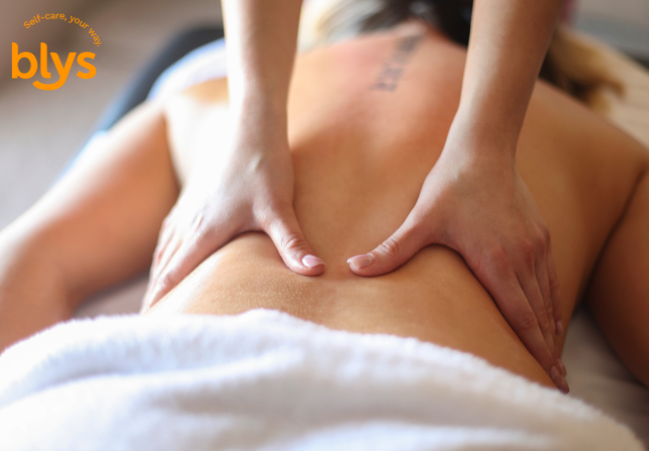
Massage therapy is no longer seen as a luxury reserved for the occasional spa visit. Across in th US, more people are turning to in-home massage as part of their regular self-care, health, and recovery routines. Whether you’re an athlete looking to speed up muscle recovery, a parent managing stress and fatigue, or someone dealing with chronic pain, the benefits of massage go far beyond relaxation and there’s science to prove it.
A growing body of research shows that massage therapy can help reduce inflammation, relieve pain, support mental well-being, and even improve sleep quality. These effects aren’t just temporary, either. When done consistently, massage therapy can become a powerful tool in improving your overall quality of life.
And thanks to at-home massage services from Blys, you don’t need to travel or wait weeks for an appointment. You can experience the same therapeutic benefits on your schedule, in your space, delivered by a qualified massage professional.
Ready to feel the science-backed benefits yourself? Book an at-home massage with Blys.
What Happens in Your Body During a Massage?
Massage therapy does far more than soothe tired muscles it sets off a series of biological responses that improve both your physical and mental health. These responses, triggered by specific massage techniques, can help explain why so many Americans are incorporating in-home massage into their ongoing wellness routines.
Increased Blood Flow and Circulation
A key benefit of massage is improved circulation. As your massage therapist applies pressure and releases tension in muscles and soft tissues, blood flow increases throughout the body. This boost in circulation helps deliver oxygen and nutrients to your cells more efficiently, while also assisting the lymphatic system in removing waste and toxins.
Enhanced circulation plays a critical role in reducing swelling, supporting faster recovery from injury, and even improving skin tone and joint mobility. A 2009 study found that massage therapy led to measurable improvements in peripheral blood flow and vascular function, especially when performed regularly.
Reduced Cortisol, Increased Serotonin, and Dopamine
Massage directly influences your body’s hormonal balance. When you’re under stress, your body produces more cortisol, a hormone linked to fatigue, irritability, and poor sleep. Massage therapy can help lower cortisol levels, while increasing the production of serotonin and dopamine neurotransmitters that regulate mood, pleasure, and emotional resilience.
In a clinical study by Field et al. (2005), participants who received consistent massage sessions experienced a 31% drop in cortisol, alongside notable increases in both serotonin and dopamine. This shift in neurochemistry can lead to reduced anxiety, better sleep, and an improved sense of well-being.
Nervous System Relaxation
Massage has a calming effect on the autonomic nervous system, specifically the parasympathetic branch responsible for ‘rest and digest’ functions. As your body enters this relaxed state, your heart rate slows, breathing deepens, and your muscles begin to release stored tension.
This can help ease stress-related conditions such as tension headaches, digestive issues, and chronic fatigue. The benefits extend beyond the massage table. Over time, regular massage can help train your body to regulate stress responses more effectively, promoting a deeper sense of calm and resilience in everyday life.
With the added convenience of at-home massage services, clients can experience these therapeutic effects without the disruptions of traffic, waiting rooms, or tight schedules. Instead, the session begins and ends in the comfort of your own space creating a more consistent and effective pathway to long-term wellness.
Massage therapy offers science-backed support for pain relief, recovery, and stress management. If you’re healing from a physical setback, remedial massage can support sports injury recovery.
Muscle Recovery and Performance: What the Research Says
Whether you’re a fitness enthusiast, a full-time desk worker, or someone recovering from surgery or injury, muscle fatigue and tension are common parts of life. Fortunately, massage therapy offers more than just momentary relief.
Increasingly, research shows that massage plays a vital role in reducing soreness, improving tissue repair, and enhancing physical performance all while supporting long-term recovery.
Reducing Delayed Onset Muscle Soreness (DOMS)
DOMS (delayed onset muscle soreness) typically peaks 24 to 72 hours after unfamiliar or intense physical activity. It’s caused by microscopic damage to muscle fibres, resulting in inflammation, stiffness, and pain. If left unmanaged, it can reduce mobility, impair performance, and even discourage people from staying active.
Massage has been shown to significantly reduce the intensity and duration of DOMS. In a 2005 study by Zainuddin et al., researchers found that individuals who received massage therapy 2 hours after exercise experienced less soreness and better muscle function compared to those who didn’t. These results suggest that even a single massage session can support quicker recovery and maintain performance levels.
For everyday Americans who enjoy working out, hiking, cycling, or simply staying active, in-home massage offers an easy way to manage post-exercise soreness without disrupting your routine.
Helping Muscles Recover and Repair
Massage doesn’t just soothe muscles; it helps heal them. When muscles are overused or strained, they require proper blood flow to begin repairing. Massage promotes circulation, delivering oxygen and nutrients to stressed tissues while also supporting the lymphatic system in removing waste products like lactic acid.
This process is particularly important for office workers or tradies who experience repetitive strain or prolonged static posture. Over time, these physical patterns can lead to chronic tightness, fatigue, or even injury. Regular massage helps restore balance and flexibility to overworked areas, giving the body a better chance to recover between activities or shifts.
Additionally, for clients recovering from surgery or injury, massage can assist in soft tissue mobilization, reduce adhesions, and improve range of motion all critical to regaining normal function.
Enhancing Performance in Sport and Daily Life
Massage is not only reactive it’s also proactive. For athletes and active individuals, regular massage can help maintain muscle tone, prevent injury, and reduce physical stress before it builds up. A systematic review by Davis et al. (2020) concluded that massage therapy plays a supportive role in performance recovery, pain reduction, and perceived muscle readiness.
But you don’t have to be an elite athlete to benefit. If you’re someone who walks daily, commutes on a bike, or spends hours at a desk, massage can help optimize your physical performance by keeping soft tissues healthy and mobile. Even tasks like lifting kids or doing housework become easier when your muscles aren’t overloaded.
With Blys’ at-home massage services, staying consistent with your recovery is simple. You can book sessions that fit your schedule, avoid travel stress, and receive tailored care in the comfort of your home.
Pain Relief and Chronic Conditions – Evidence You Can Trust
Living with chronic pain can be physically draining and emotionally taxing. Whether it’s ongoing back discomfort, fibromyalgia symptoms, or tension headaches that interfere with daily tasks, massage therapy has shown real promise in helping people manage these conditions. Unlike temporary fixes, massage offers ongoing support grounded in evidence and tailored to individual needs.
Chronic Back Pain
Back pain is one of the most common reasons adults seek help from tradies and office workers to parents and retirees. Massage helps by relieving muscle tightness, improving spinal alignment, and increasing blood flow to affected areas.
- A Cochrane review by Furlan et al. (2015) found massage more effective than no treatment and comparable to other common therapies like exercise or acupuncture.
- The study noted improvements in pain intensity, physical function, and short-term relief, especially with regular sessions.
- Massage may also reduce reliance on pain medications when included as part of a long-term care plan.
Fibromyalgia
Fibromyalgia is a complex condition that causes widespread muscle pain, fatigue, and poor sleep often with no clear cause. Because it affects the nervous system and pain perception, massage therapy can offer gentle yet effective relief.
- According to a study by Field (2002), massage therapy led to improvements in sleep quality, pain levels, anxiety, and overall mood in fibromyalgia patients.
- It works by relaxing tense muscles, improving circulation, and reducing the stress hormone cortisol helping ease flare-ups over time.
- Since fibromyalgia can make even simple outings exhausting, in-home massage services provide a practical and stress-free solution.
Tension Headaches
From long workdays to poor posture and daily stress, many people experience tension-type headaches. These can feel like a tight band around the head or deep pressure in the neck and shoulders.
- Massage helps by relieving muscle tension, especially in the neck, shoulders, and upper back areas often associated with headache triggers.
- It also improves blood flow, supports better posture, and activates the body’s relaxation response, lowering the likelihood of recurring pain.
- Clients often report reduced headache frequency and a decrease in pain severity after consistent sessions.
Massage therapy is more than a short-term solution it’s an accessible and effective way to manage chronic pain over time. And for clients with mobility concerns or those who prefer privacy and comfort, Blys’ in-home massage services bring professional care directly to your door.
Dealing with persistent discomfort? Discover how remedial massage can help manage chronic pain.
Mental Health and Mood Benefits of Massage
Massage therapy isn’t just about easing physical tension it also plays a valuable role in supporting mental well-being. As modern life becomes increasingly fast-paced, many Americans are looking for natural, non-invasive ways to manage stress, anxiety, and sleep issues. Massage is now widely recognized as a supportive therapy for improving emotional health and restoring balance.
Stress and Anxiety Relief
When you’re stressed, your body goes into fight-or-flight mode, releasing hormones like cortisol that keep you on edge. While this response is useful in short bursts, chronic stress can lead to muscle tension, digestive issues, mood swings, and burnout.
Massage helps by calming the nervous system and stimulating the parasympathetic response the body’s rest-and-recover state.
- A research found that massage therapy significantly reduced symptoms of anxiety and stress, especially when performed regularly.
- The relaxing effects of massage lower cortisol levels and increase serotonin and dopamine, creating a sense of calm and emotional stability.
- Clients often report feeling mentally clearer, more grounded, and better able to cope after each session.
Managing Depression Symptoms
While massage isn’t a replacement for professional mental health care, it can be a helpful part of a holistic support plan. Physical touch, human connection, and nervous system regulation all contribute to mood improvement.
- For people experiencing mild to moderate depressive symptoms, massage has been shown to reduce feelings of hopelessness, fatigue, and emotional overwhelm.
- The hormonal shifts that occur during massage therapy can promote a more positive outlook, especially when sessions are consistent.
- In-home massage offers a low-pressure environment for clients who may find clinics or public spaces overwhelming.
Better Sleep Quality
Poor sleep affects everything your energy, memory, mood, and immune function. If you’re tossing and turning at night, massage might help restore your natural sleep rhythm.
- A 2011 study found that participants receiving massage therapy reported notable improvements in sleep quality, with reduced sleep disturbances and longer rest durations.
- Massage promotes deeper sleep by easing muscular and mental tension, helping the body reset its internal clock.
- It’s particularly helpful for those with insomnia tied to anxiety, chronic pain, or shift work.
Whether you’re facing day-to-day stress or navigating a period of emotional strain, massage therapy offers real, research-backed support. And with Blys, you don’t need to leave your safe space in-home massage services let you relax and reset without stepping outside.
The Convenience and Consistency of At-Home Massage
While the science behind massage is clear, what often determines how much benefit you get is how consistent and comfortable your sessions are. That’s where Blys’ at-home massage services make a real difference.
By bringing qualified therapists directly to your door, Blys helps clients stay on track with their wellness goals without the hassle or disruption of travelling to a clinic.
Here’s how at-home care elevates the experience and results:
- Consistent care with the same therapist: Building a relationship with a trusted therapist allows for more personalized, effective treatments. Blys gives you the option to rebook your preferred professional, making it easier to address ongoing concerns like chronic pain or recovery goals with continuity.
- No travel stress = more relaxing sessions: When you don’t have to commute or sit in traffic before or after your massage, your body and mind remain in a relaxed state for longer. This makes every session more restorative and more convenient.
- Perfect for elderly clients, parents, and busy professionals: Getting out of the house isn’t always easy, especially for clients with mobility issues, young children, or demanding work schedules. At-home massage eliminates logistical stress, offering comfort, privacy, and flexibility, all without compromising on quality of care.
- Flexible timing that suits your schedule: With Blys, you can book a massage before or after work, on weekends, or even at short notice. This flexibility makes it easier to stick to a regular self-care routine and experience long-term results.
So whether you’re managing pain, chasing performance goals, or seeking stress relief, science backs massage as more than a luxury it’s a powerful, proven way to support your body and mind. And with Blys, it’s now more accessible than ever.
Looking for a professional you can trust? Browse vetted Blys therapists near you.
Wellness Backed by Science and Delivered to Your Door
Massage therapy is no longer just a feel-good luxury it’s a proven, science-backed approach to better health. With consistent sessions, clients experience real improvements in physical recovery, pain relief, emotional balance, and overall well-being.
It supports a wide range of needs, from managing chronic conditions like back pain and fibromyalgia to improving sleep, reducing stress, and boosting performance.
Across multiple studies, massage has shown the ability to:
- Lower cortisol levels and reduce anxiety
- Ease tension and soreness after exercise
- Improve sleep quality and mood
- Support the body’s natural recovery processes
Yet, the key to unlocking these benefits lies in consistency and that’s where in-home massage with Blys becomes invaluable. Many people struggle to maintain regular treatments due to busy schedules, mobility issues, or the inconvenience of travelling to a clinic. Blys removes those barriers entirely by bringing professional care straight to your door.
You can choose a therapist that suits your needs, schedule appointments that fit into your lifestyle, and enjoy treatments in the comfort of your own home whether it’s early morning, after work, or on weekends. It’s personalized wellness, made simple and accessible.
Whether you’re recovering from a tough gym session, managing chronic stress, or simply want to feel more balanced in your everyday life, massage therapy offers support that’s both evidence-based and deeply practical.
Want to learn more about how massage helps with mental stress? Read how remedial massage helps relieve stress.





